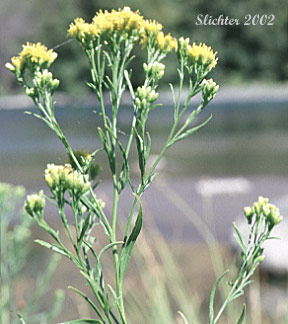 The
photo at right shows the upper stems of western goldenrod. Note that it is
well branched and that the inflorescence is relatively flat-topped.
The
photo at right shows the upper stems of western goldenrod. Note that it is
well branched and that the inflorescence is relatively flat-topped.
Western goldenrod is a perennial wildflower with erect, much-branched stems arising from 50-200 cm high. The branches are glabrous (lacking hairs) and generally ascend or are nearly upright. The numerous leaves are sessile and narrowly linear in outline with 3 nerves or veins. They measure from 6-10 cm long and are at most 1 cm wide. The lower leaves are deciduous by the time plants bloom.
The inflorescence is a leafy, compact to open set of corymbiform panicles. The outline as viewed from the side appears slightly rounded to flat-topped. The yellowish or pale green involucre of individual flowers is about 4 mm high and somewhat glandular. The involucral bracts are narrow with acute tips. The 15-30 ray flowers are yellow in color and measure 1.5-2.5 mm long. They surround a narrow yellow disk which consists of fewer disk flowers.
Western goldenrod is probably one of the easier goldenrods to identify in the Gorge. Key characteristics include the much branched stems with the flat-topped inflorescence and narrow, entire-margined leaves.
Western goldenrod may be found in damp ground along rivers and streams in the lower valleys and plains.
Western goldenrod may be found from southern British Columbia south to California and east to Alberta and south to Nebraska and New Mexico.
In the Columbia River Gorge it is found between the elevations of 0'-200' across the length of the Gorge.
These 3 photos show close-ups of the inflorescence of western goldenrod as aseen along the old highway about one mile east of Celilo, OR..........September 2007.

